Jack and Me and Coochie Brake
Excerpted from Finding Myself Lost in Louisiana
By Keagan LeJeune
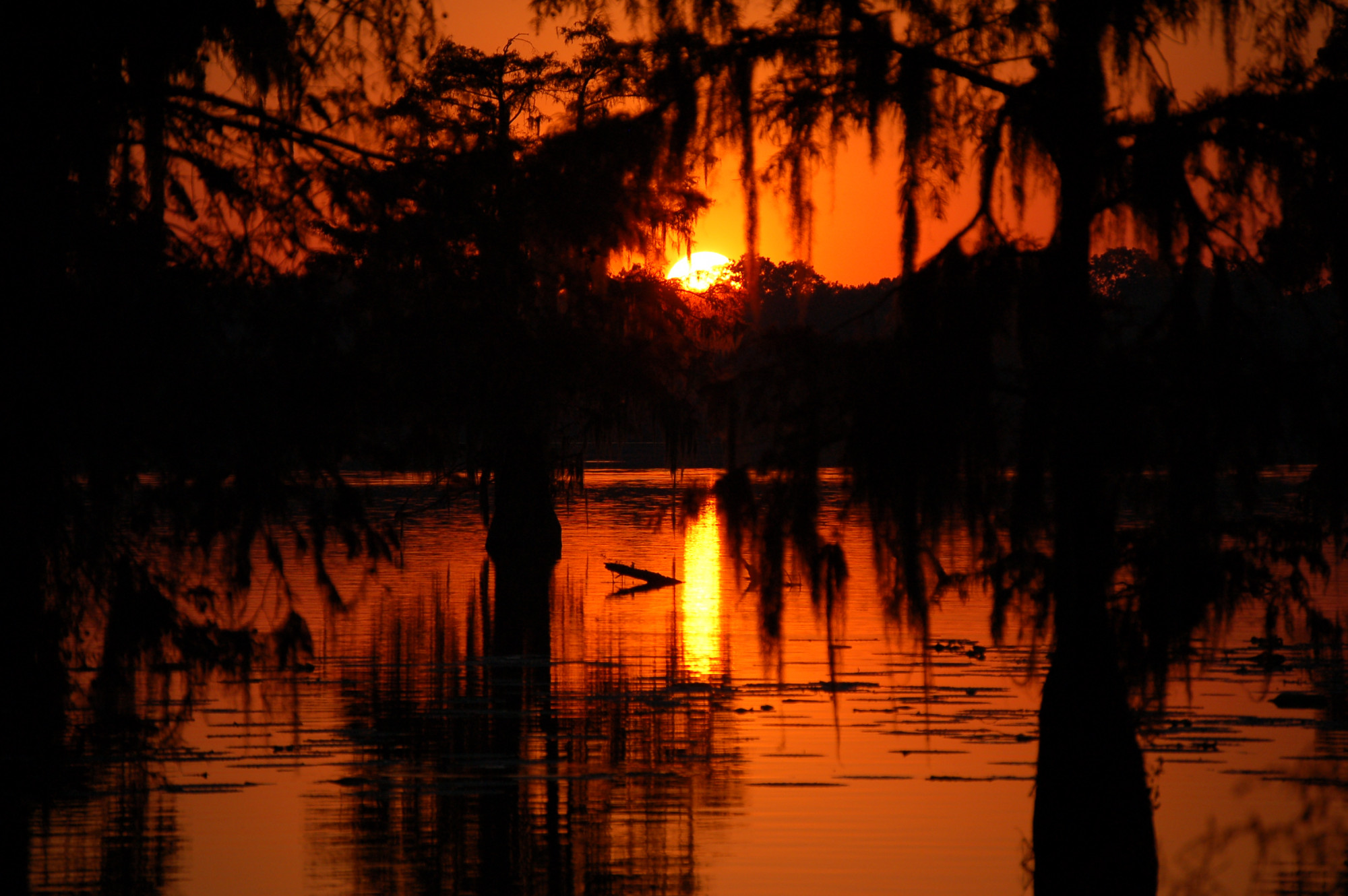
Photo by JC Winkler. Courtesy Wikimedia Commons
The El Camino Real is a backbone. It’s a spine. It’s a cord that holds up central Louisiana. If you flayed a man and saw the avenues of blood we call veins and arteries, you’d be looking at something similar to the web of roads jutting off that main highway. If you pulled back skin to study the network of nerves woven closely to the bone, you’d have an idea of the often-told stories branching from that historic “Royal Road.”
But don’t let my melodrama confuse things. The King’s Highway was very real. One branch ran from Mexico City (the Viceroyalty of New Spain) to Natchitoches. There, it opened to wilderness, disputed territories, and the French, and as it did, it acted as a gate or a door or hidden entryway, like a bush-covered mouth of a cave. Soldiers, bandits, roamers, raiders, out-of-touch autocrats, monks, caravans carrying ingots or colonial pieces of eight—all poured through the thoroughfare.
And this is where the drama slips in.
Gold. Silver. Other treasures untold. These wanderers left it there, or so people say, stashed in various hidey-holes scattered around Natchitoches.
You can find it. That is, if you have the eye, if you know the way.
The problem is I’ve never had a mind for treasure. I mean, I’ve heard the stories. I’ve seen the maps. I’ve flipped through the pages of Tales of Louisiana Treasure. I’ve read every word of Louisiana-Mississippi Treasure Leads. I’ve even pen-palled with a prisoner who deciphered an old diagram that supposedly led to Laffite’s strongbox buried near historic Sallier Oak in Lake Charles. But when it comes to actual treasure hunting, I don’t have the guts for it.
True treasure hunting, I think, requires two simple things—courage and conviction. But when my car’s jostling down an unpaved road or I’m trudging through a patch of scrub pine, they peter out on me. As for my lack of courage, my problem’s been the fear of wasting time. For conviction, it’s either been no faith that a fortune’s actually out there or not enough faith to take a risk.
It’s a concern, I know. The real trouble is, though, it’s not just in treasure hunting.
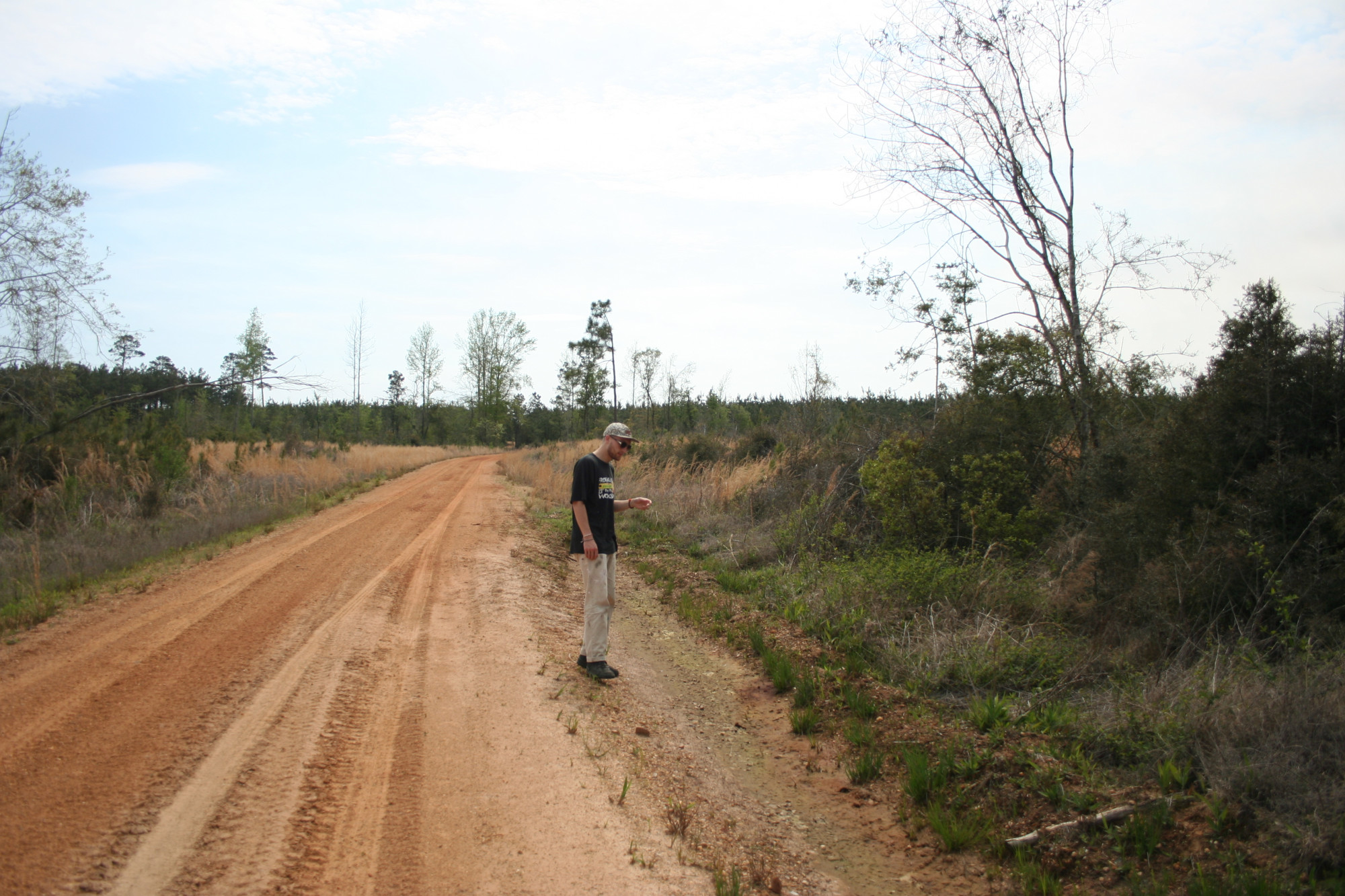
Jack takes a break on the smoothest portion of Coochie Brake road. All photos courtesy the author
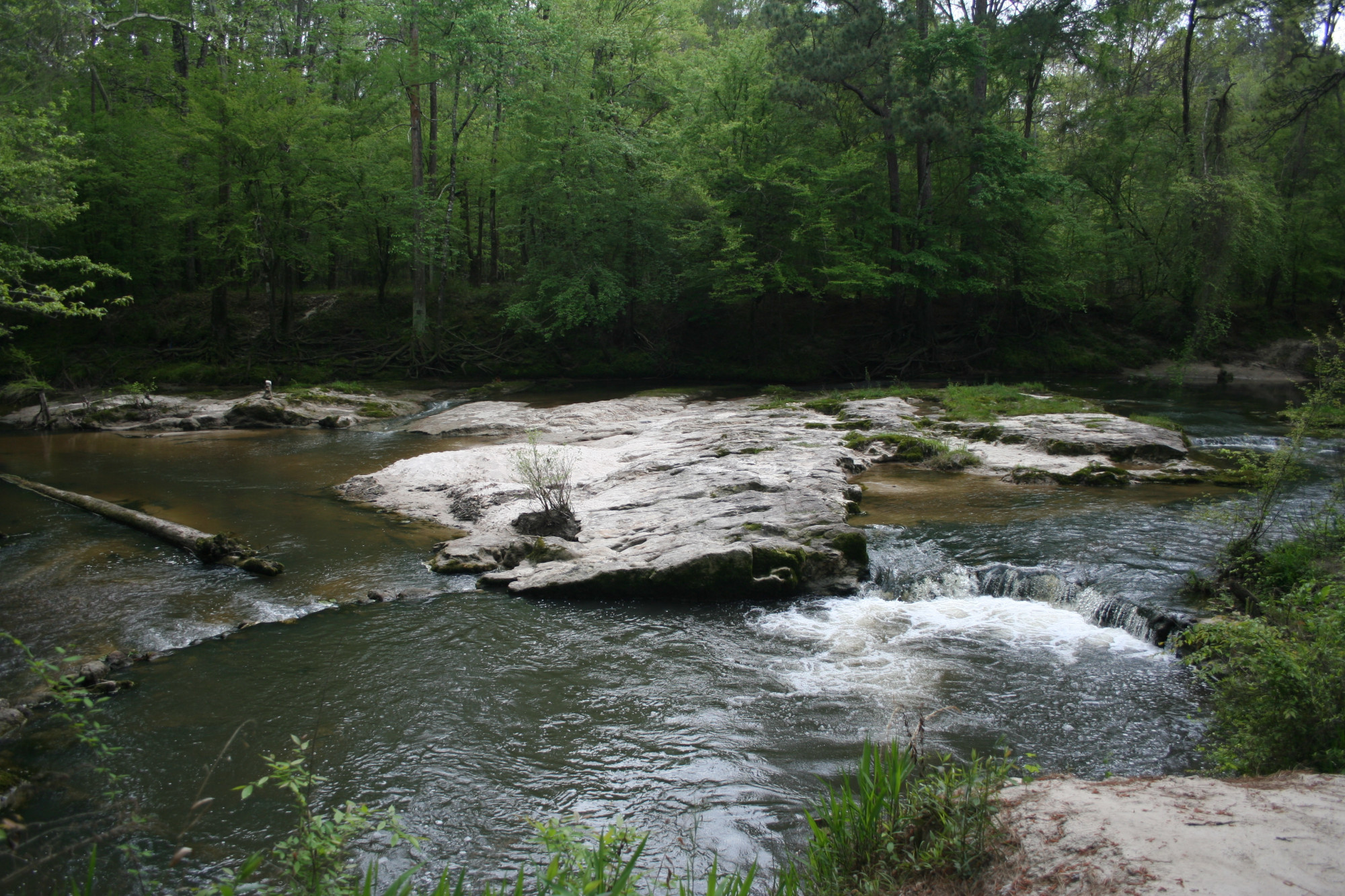
Many believe buried treasure waits in the washes of Kisatchie National Forest.
So I start. So I plan. So I scheme. So I begin my search for treasure close at home.
There’s just one thing I have to do first. I call up my newfound friend Jack.
Jack’s a graduate student. He’s a poet. He’s a walker of wild trails, a forager for funny mushrooms, someone as curious as I am about stories, and one of the only people I know willing to go camping with someone like me, someone who’s okay with settling for cold food and cold nights of uncomfortable camping, at least for a few days, if it means we don’t need to haul along too much junk.
“Want to help me hunt for Coochie Brake?”
“Sure,” he says. “Definitely.…What’s that?”
“There’s a place in Winn Parish called Coochie Brake,” J. Maxwell Kelley told writer C. Renée Harvison when she interviewed him in 1990. A swampy wood running more than seven hundred acres, Coochie Brake sits only about fifteen miles outside of Winnfield, but it’s so damned hard to get into, even many locals have never actually stepped foot in it. As the former mayor of nearby Winnfield, Kelley had heard his share of stories about the legendary place, even if he preferred to keep his distance.
Legends say otherworldly trees and odd-looking rocks and a profusion of fauna can be found there. Some claim the world’s largest tupelo gum was discovered there in 1913. Some say a high hill in the brake, a spot called Robber’s Roost, stood for years as “a great vantage point” for bandits watching “travelers along the old wagon trail or the law.” Some even believe, or at least say some folks believe, that parts of Coochie Brake are “voodooed or had a hex put on it . . . whereas anyone who goes near it, something bad happens to them or a member of their family.”
“It’s supposed to be a strange place,” I say to Jack. “A weird place.” And then I try to explain to him exactly what a brake is.
I stammer. Brake refers to the physical aspects of the landscape—a thicket, a swamp, an impediment. Early travel writer William Darby used brake in 1816 when he described swampy portions of Louisiana, but Samuel Lockett seemed to be the first in Louisiana to apply the term to mean “trees of considerable size.” Brake appears on a Louisiana map around 1895, and the use of the term quickly spread through the Tensas and Red River basins. There, the term meant either a thicket, a canebrake, or a low wetland abundant with gum and cypress trees. In every case, the point was clear—when you run into a brake, you run into the same thing—a wall of a landscape, an impenetrable barrier, an untamed stops-you-dead-in-your-tracks.
I like the word brake for a place. It’s a good little metaphor to me. It originates from a German word meaning rough and broken ground, and to my ears it perfectly describes what this sort of landscape does to you . . . or your horse . . . or your wagon . . . or even your little Nissan Rogue.
Telling Jack any more than that seems impossible, or pedantic, or simply just beside the point because when scavenging for silver, especially in Coochie Brake, there’s real work to do, and it’s a good idea to stay focused.
About treasure hunting, everyone will tell you to keep your eye on the prize, and they’ll spit out the same advice about Coochie Brake, or sort of. In the brake, about the best thing you can do is keep your eyes peeled, and your wits about you.
Coochie Brake, you see, has been everything from a “haunt of moonshiners to the hideout of gangsters.” It’s been a home for spirits and a haven for outlaws. Loggers and quarry operators and roustabouts have tried to make big paydays working the area, the “big opening” people call it, and have found themselves stymied. Hunters have marched in there and come out with a string of crazy stories. Gold hunters have tried and gotten turned around. Even local boys have found themselves lost in there.
Hidden in plain sight, Coochie Brake holds an almost supernatural atmosphere for Louisianans. The State of Louisiana’s Office of State Parks acknowledged that many locals have heard of the “wild and eerie nature of the site” that held “an aura of history and mystery . . . within its rocks, forests, and creeks.” But few know it firsthand.
One local confessed that Coochie Brake was so dense and so impenetrable that “most Winn citizens have never seen this marvelous phenomenon of nature . . . 700 acres . . . an ostentatious display of winding creeks, trees, undergrowth, birds and boulders, caves and tunnels.” Even to those “who had the courage to venture into its weird interior,” another person said, the place has remained “something of a mystery.”
Back when he was a younger man, Darryle Kent Lacour had the wild idea to trek into it. “My discovery of Coochie Brake occurred while hunting in the area in 1970,” he recalled. “I noticed a large section of trees. It looked like the perfect place for hunting game.”
Lacour did a stint in the Army from ’64 to ’67, so he didn’t mind marching through the thicket. In fact, he enjoyed being out in the woods, when his work at Winn Dixie allowed it. He liked to hunt and fish a little, but as a Civil War buff, he spent an equal amount of time with his metal detector rooting around for artifacts.
It was during his very first foray into the brake when he encountered something strange. His hiking had run him into the waters of Nantachie Creek creeping through the woods. Opting for adventure and discovery rather than calling it quits, Lacour decided to travel the bank until he found the spot in Coochie Brake that held the mouth of that creek. “It was like walking into another world,” he said. “Or like finding a new island in the Pacific Ocean. Strange sounds came from the brake, and trees of all kinds grew in thick abundance for miles.” He plunged deep into the dense woods before he decided to turn around. But it was too late. Lacour was bit.
From 1970 to 1973, Lacour’s curiosity lured him into Coochie Brake several times. Each time he’d go off wayfinding through the brush; each trip seemed to unearth a new surprise. “Deep in the brake were large rocks,” he said, “which appeared to be an old house or foundation.” Huge clumps of wizened trees greeted him. On several outings, he encountered strange animals, larger than normal, with unusual markings. Flocks of parakeets too, he claimed to have seen. “Their calls were lonely and eerie,” he said, but they paled against the other sounds. “Standing there at the edge of the brake,” he said, “I could hear large splashes in the distance and sounds of bullfrogs or alligators bellowing, that rattled my eardrums.”
His last trip came in 1973. He put a canoe in the Nantachie’s goopy water and ladled for a bit with his paddle. It was meant to be an extended hunting trip, but it lasted only thirty minutes. “I came to a small mound in the brake covered with alligators, stump tail water moccasins and giant swirls in the water everywhere,” he told people. “I took a compass reading,” he confessed, “but the needle would never stop spinning.”
After that, he wouldn’t go back.
I pack the tent, sleeping bag, matches, lantern, and the other this-and-thats into a bin on Saturday. On Sunday, I play with a map and some old newspaper clippings. On Monday morning, early, before dawn, I load the bin into the car. Around ten, I hear from Jack that he’s ready. By 10:05, I’m driving over to pick him up.
Two and half hours of two-lane highways needling us north is what we have ahead of us. During that time, after we get settled a little, we wonder about Coochie Brake some. Mostly my tongue’s a lead weight when I try to describe it. That’s a puzzlement to Jack, so he does some digging.
His phone-scrolling finds a story online about Coochie Brake. “My personal opinion is that the brake was formed by a fragment from the Giant Meteor that hit the Gulf of Mexico thousands of years ago,” is how Lacour explains it.
It’s a story people like to tell—that the impact of an otherworldly rock created the huge swampy depression in the brake and the pieces the meteor broke into are the odd-looking rocks and boulders visitors see still when they roam the grounds. The story also accounts for the swirling compass needles and bizarre creatures, that is to people who subscribe to it, since the meteor would likely have strange magnetic properties and maybe even radioactive decay emitting from it. It sounds scientific. Maybe that’s why people like that story. It sure makes Jack’s eyes light up.
But the meteor is only one theory about why the brake is the way it is. Other local historians claim that the entire brake formed when a fault line buckled. Some layers of rock shot up, and others sank. The latter forming the depression which over the years turned into a massive cypress swamp with a shallow lake at its center. The cypress trees inside the swamp became giants because they were fed by the lake’s mineral-rich water. The fault line eruption also exposed deposits of granite and sandstone and filled a portion of Coochie Brake with boulders and rocks and outcroppings.
And then there’s the people who simply say Coochie Brake is cursed, and that explains it all.
It’s enough of a debate to get Jack’s eyes roving and my hand off the wheel. “So where is it?” he says. “Where are we going?” He starts poking his phone and I start rummaging in the backseat, my fingers wiggling to find the edges of the map stowed in the seat pocket.
When I pull it up front, I swerve just a tad trying to show him the roads I want to try and the infamous spot we absolutely must find—Lying Horse Rock.
Of all the places rumored to be in the brake, Lying Horse Rock might be the most legendary, and the spookiest. It supposedly holds the buried ill-gotten gains of outlaws. The pockmarked ground around it stands as hard evidence. Every shovel mark is someone’s missed chance. Every hole is someone’s whole night spent digging. Add them all up and they reach to the heart of the eager years people treasure hunted here. Put them in a sack, and you have all the old ghost stories that go along with them, all the hearsay, all the what-ifs of what happened that one time, all the things that match just what Maxwell Kelley said: “We’ve had some say that old so-and-so died because he got too close to Lying Horse Rock, but I don’t put much faith in all that superstition.”
Jack’s ears perk up when I mention that, and now we’re both anxious to find that mysterious boulder, me a little more on the nervous side. Proof of that is I have a bottle of holy water stowed in my car’s center console. That’s a secret I don’t share with Jack.
What I tell him instead is how lost I’ll likely get us. It’s a running theme with me after the hurricanes, but on this trip, there’s so little real information about the location of that rock to go on. I don’t have more than a few fuzzy map coordinates, which I’ve translated into one large circle drawn on the map. It’s nothing more than a stab in the dark, but I think it’s our best bet.
It starts with Harrisonburg Road, which is an old colonial trail splintering from the El Camino Real. The current version of Harrisonburg runs a good portion of the course we’ve planned, or so our fingers sliding around the map tell us. If we hit it, we can cover all the potential spots we want to try, my circle included.
But some places don’t seem right for circles. Some places don’t fit in the boundaries we draw for them. They seem to wiggle free of the normal world. There, the ordinary and the supernatural overlap, just like shades of a Venn diagram, and the everyday mingles with the strange. When they do, a plain-Jane walk turns into something eerie. A noise doesn’t stay just a noise. A rattle or a moan or even birdsong becomes a sound unusual, one that’s full of the unexplained. We know not how. It just happens. And when it does, this weird space, this uncanny place, becomes full of opportunities. Maybe power. Maybe gold. Maybe memories of old ways now gone. Maybe ghosts.
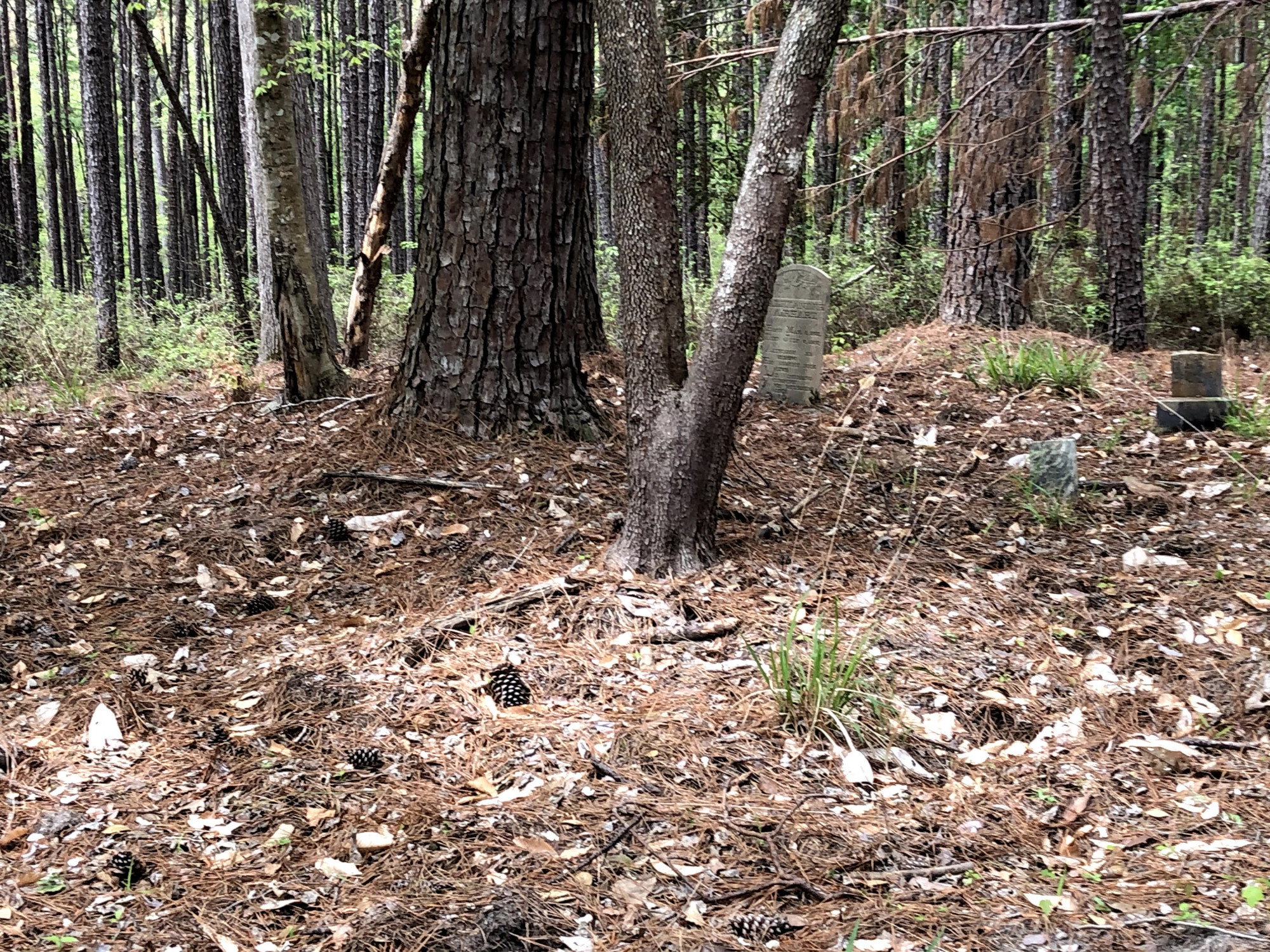
One of the old cemeteries in the Kisatchie National Forest.
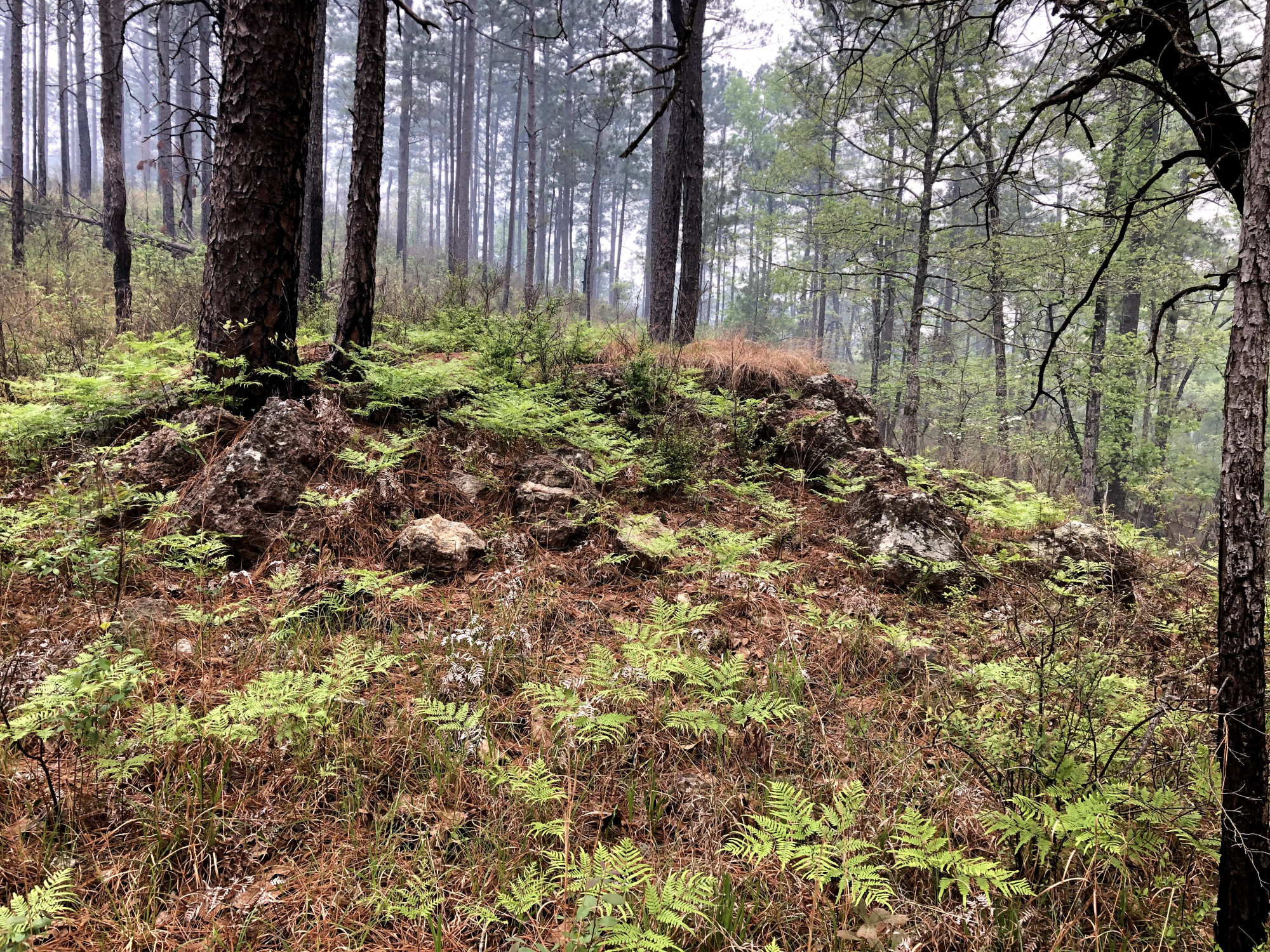
Some of the Buried Rock Formations in the Coochie Brake area.
Coochie Brake seems like the right sort of place for that. Its topography, its terrain, its giant trees and curious rocks, its unusual tunnels, its ostentatious display of raw nature creating a rugged and evocative natural world—all these features mark Coochie Brake as a place where the commonplace shakes hands with the bizarre.
So like Alice traveling down the rabbit hole, Jack and I tumble along Louisiana’s highways, and like her, there are people on our trip—mostly Jack—drinking and eating and smoking funny things. And there are people trying to taste adventure and bite off a little fun. And there are people, like me, who are looking for an opportunity to be transformed… to grow giant, or to shrink. To take a risk. To set doubt aside. To prove to myself that my mundane assumptions about what makes the world go round are wrong.
From Finding Myself Lost in Louisiana. Used with permission of the University Press of Mississippi. Copyright © 2023 by Keagan LeJeune.



